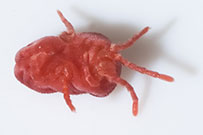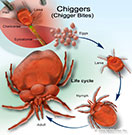home | fall garden | shade garden
Chigger Mite
Chiggers are not insects. Chiggers are the juvenile form of a specific family of mites. Mites are arachnids, like spiders and scorpions and are closely related to ticks. Chiggers are more prevalent in hot, humid areas and are rarely found in far north areas, mountains, or deserts. They congregate in groups in matted vegetation and low plants and bushes where they have more access to prospective hosts. Chiggers are affected by temperature. They are most active in afternoons and when the ground temperature is between 77 and 86 degrees. They are almost invisible to the unaided eye measuring only 1/60th of an inch. They have an orange to red tint. Contrary to public opinion, this color does not result from sucking blood from their host. Chigger mites do not burrow into the skin, suck blood, or lay eggs inside of their host. Instead, they attach themselves to host, which are mainly animals, but humans are often an accidental host. The chigger mite will pierce the skin, inject enzymes into the bite that digest cellular contents, and then they suck up the digested tissue through a tube formed by hardened host skin cells. The larval stage is the only parasitic stage of the mite's life cycle.
 |
 |
 |
